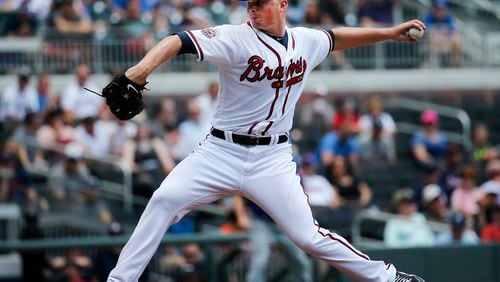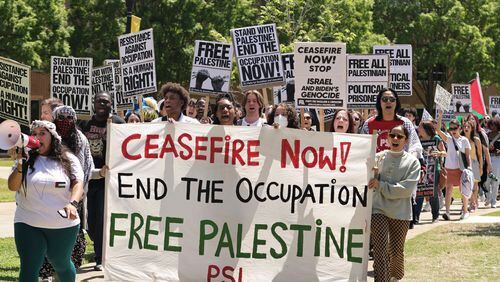The first major trades of the Braves’ rebuild were understandable. The newly installed front office of John Hart and John Coppolella shed Jason Heyward and Justin Upton, both set to become pricey free agents. Also outbound were Evan Gattis, whom the Two Johns didn’t believe could play every day for a National League team, and the great closer Craig Kimbrel, the carrot in persuading San Diego to absorb the $46 million owed Melvin Upton Jr.
Established and expensive assets were sacrificed to restock a barren farm system. The fruits of those four trades: Tyrell Jenkins, Mike Foltynewicz, Rio Ruiz, Max Fried, Jace and Dustin Peterson, Mallex Smith, Matt Wisler and a draft pick spent on Austin Riley. And also Shelby Miller.
The Braves have had no cause to regret those deals, all made between the 2014 and 2015 seasons. Emboldened by early success, they let their creative juices flow. Three subsequent trades saw them offload three gifted and established major-leaguers, all under long-term club control, their ages ranging from 24 to 26. In their second round of major moves, creativity met cold reality.
The Whiff: On July 30, 2015, the Braves sent starting pitcher Alex Wood, closer Jim Johnson, reliever Luis Avilan and infield prospect Jose Peraza to the Dodgers for Hector Olivera, a 30-year-old infielder who signed with L.A. for $62.5 million that spring and who hadn't played in a big-league game. Also included: pitching prospects Zachary Bird and Paco Rodriguez and, via Miami in this three-way deal, a draft pick.
The Braves liked Olivera enough to bid on his services that spring – they sent then-manager Fredi Gonzalez, also born in Cuba, to meet with him – and sprang at the chance to get him for roughly half what the Dodgers paid. They saw him as a middle-of-the-lineup complement to Freddie Freeman. “The first building block,” Hart called Olivera, who was arrested for domestic violence April 13, 2016 and suspended 82 games by MLB. In July the Braves traded him to San Diego, which released him, for Matt Kemp.
Bird was claimed by Texas in the Rule 5 minor-league draft; Rodriguez was released. The draft pick became high school pitcher Joey Wentz; he's rated by MLB.com as the Braves' No. 13 prospect. Johnson re-upped with the Braves after the 2015 season and is here still. Avilan remains with the Dodgers as a get-out-the-lefty guy.
Peraza was seen by the Frank Wren administration as the Braves’ No. 1 prospect; the new regime preferred Ozzie Albies to Peraza, whom they deemed a slap hitter who could run but rarely walked. The Dodgers flipped him to Cincinnati that winter. The Reds parted with Brandon Phillips to make room for Peraza. Through Friday morning, he was hitting .250 with an on-base percentage of .277.
Wood was the Braves’ Round 2 pick in 2012. He had Tommy John surgery as a Georgia undergrad. Even as he was winning big-league games, the Braves lived in fear that Wood’s “funky” – his word – mechanics would lead to a physical breakdown. Sure enough, he missed three months last season with elbow inflammation. This year he’ll be an All-Star.
He’s 8-0 with an ERA of 1.86, which ranks the second-best in the majors, and a WHIP of 0.92, which ranks fifth-best. He spent 10 days on the disabled list recently, but has been no less effective on returning. He makes $2.8 million, less than a quarter of what the Braves spent on the designated for assignment Bartolo Colon, and is under club control through 2019.
True, the Braves cut their losses and landed Kemp, who has become the desired lineup counterweight. Still, the sight of Wood in Dodger blue is an ongoing reminder of their overreach. A team rebuilding around young pitching dumped a left-hander who’d be their No. 1 starter for a guy who took 98 at-bats.
The What-The-Heck?: On Nov. 12, 2015, the Braves sent Andrelton Simmons to the Angels for shortstop Erick Aybar and pitching prospects Sean Newcomb and Chris Ellis.
Certain members of the Braves’ front office – though apparently none with veto power – hated this trade. Fan reaction was even more vitriolic. How, people asked, do you trade the best defensive shortstop since Ozzie Smith?
The rationale: The Braves feared Simmons would never hit. In 2014 he finished sixth-worst among MLB batters in OPS; he was 13th-worst the next year. The Braves thought Aybar, scheduled to become a free agent after the 2016 season, could cover them until Albies was close to ready. Said Coppolella: “You can make an argument that we’ll win more games with Aybar.”
Simmons hit a bit better in Year 1 in Anaheim, but managed only a WRC+ (weighted runs created, adjusted for ballparks) of 91. League average is 100. This year his WRC+ is 106. His on-base percentage is .333, the best since his rookie year. His defense remains stellar. His Baseball-Reference WAR value is 3.4, ninth-best among position players.
Ellis was traded to St. Louis last December for Jaime Garcia. The Braves dumped Aybar, who’d had a WRC+ of 59 and a WAR of minus-0.4 over 97 wretched games to Detroit for a middling minor-leaguer last August. As for Newcomb, who arrived as the Angels’ top-rated prospect …
His four big-league starts have yielded an ERA of 1.48 and a WHIP of 1.068. He has 21 strikeouts against eight walks. It took until the fourth inning of Start No. 3 before teammates gave him a lead; only in his final inning of Start No. 2 has he appeared to be straining.
Owing to Newcomb’s promise, we can’t fully grade this deal. Even if we tried, it’s apple-to-oranges: Which is more valuable – a top-of-the-rotation left-hander or a peerless defensive shortstop who at his best hits just enough? Probably the latter, given that a shortstop plays every day. Still, this panned trade could yet pan out.
The Windfall: On Dec. 8, 2015, the Braves traded Miller to Arizona for outfielder Ender Inciarte and prospects Dansby Swanson and Aaron Blair.
Even though Blair flubbed his major-league audition and Swanson has struggled in his first full season, this remains a triumph. The latter was the No. 1 overall draftee in 2015; today he’s the face of his hometown franchise. Inciarte is a Gold Glove center fielder who’s hitting .308. The Braves got the spine of their rebuild – and, not incidentally, Simmons’ long-term replacement – in one stroke.
Miller, very good in his season here, has had no luck in Arizona. He had an ERA of 6.42 last season and was, for a time, sent to the minors. He’d been better over his first four starts this season, whereupon he was diagnosed with a torn elbow ligament. He had Tommy John surgery in May.
The Verdict: The first major trade of Round 2 of the Braves' redo was awful. The second hinges on Newcomb. The third was the best trade by any team this century. If the Braves didn't ace this section of the exam, neither did they flunk.
About the Author







